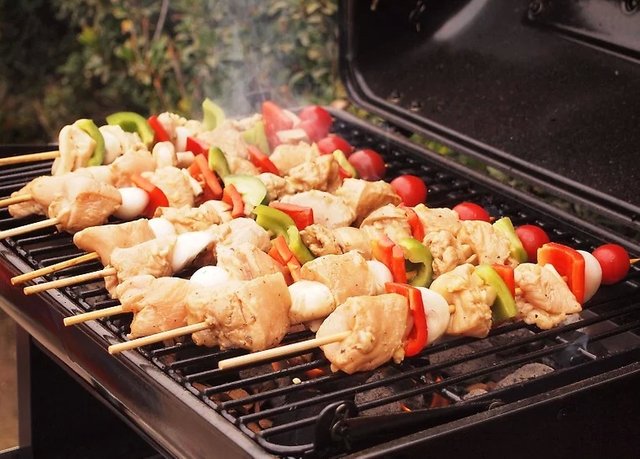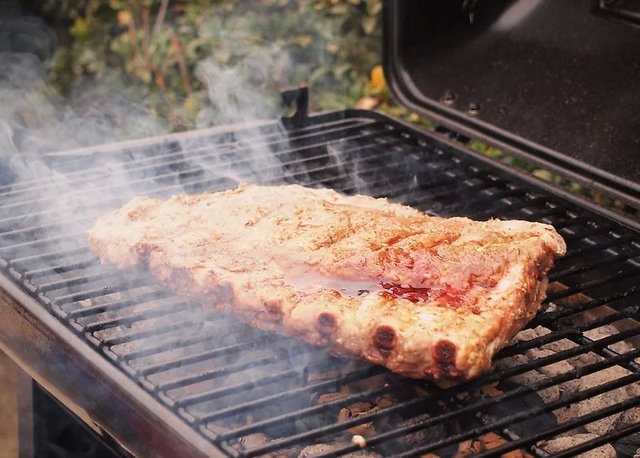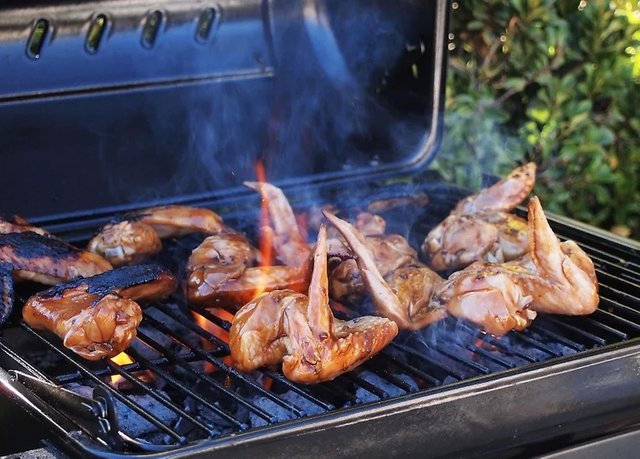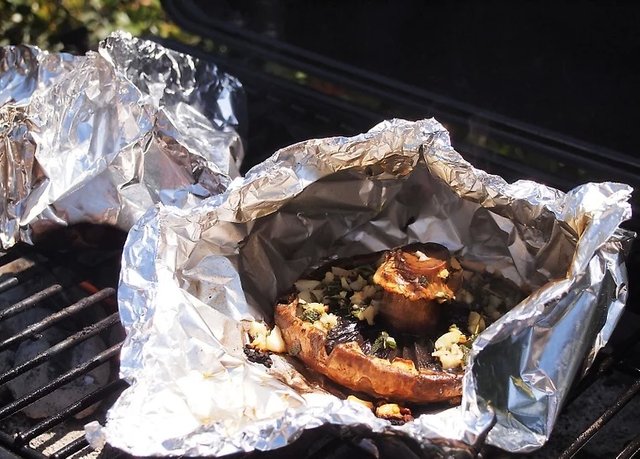How to Barbecue
Barbecue has the potential to lift even the lowliest meats and vegetables from mundanity into the sublime. That rich combination of smoke and sear on charcoal grills keeps many pitmasters dedicated to their craft, constantly looking for better ways to cook their ingredients. Getting great barbecue is equal parts science and art. See Step 1 for a detailed look into several interesting techniques that can make you a more accomplished barbecuer in minutes.
1: Utilizing Essential Tips for All Barbecuers
Keep your grill clean and maintained. Get used to cleaning your grill lightly before each cook, and then heavily about once or twice a year. Grease and oils can build up on the tops and bottoms of the grate, becoming rancid in warmer weather and imparting "off" flavors to your food. Use a putty knife and wire-bristle brush to clean food and debris from the tops and bottoms of grates or rods. Use a scraper on solid grill panels.
In your heavier cleaning sessions, try using an enzymatic cleaner specially designed for grills. Enzymatic cleaners will do a quick number on soot, ash, and particulate buildup without leaving any soap residue for you to taste when you bite into your first pork chop.
Get used to working with charcoal grills. Gas grills are convenient, cheap, and easy to clean — and there's nothing wrong with them. But if you want to elevate your game and really barbecue, resign yourself to using a real grill, a charcoal one. Charcoal grills have at least four distinct advantages over gas grills:
They get much hotter. Hotter grills mean quicker cooking times when you're ready to put food to grill.
They burn wood, which imparts more flavor. One recent study found that burning charcoal released a compound called guaiacol, which has a smoky, bacon-y aroma.
They seamlessly allow for smoking, which imparts even more flavor.
They offer the primal thrill of actually burning wood.
Try to cook with thicker cuts of meat. Assuming you're not trying to cook really big pieces of meat — more like porterhouse steaks and pork chops — thicker is better. Why? Thicker cuts give more of the perfect bbq combo: Crispy, seared outsides and tender juicy insides. A thicker steak, for example, has time to develop a nice brown sear over lower heat while the inside of the steak cooks. By the time a thin steak develops a hearty crust on the outside, the inside has cooked completely. Simple rule of thumb: Buy steaks that are between 1–2 inches (3–5 cm) thick.
Stick with simple seasonings. Salt and pepper are the two seasonings you'll get to know best on your quest to become a better griller. These are the two
necessary ingredients for most cuts of meat. Everything else is incidental. Sometimes, a smoky rib rub is just what the doctor ordered. If you bought a nice cut of meat, a lot of crazy seasonings and flavors will just detract.
Salt your meats about 40 minutes in advance of grilling. Salt draws moisture out of the meat. This occurs almost instantly, so, if you apply salt just before you grill, the salt pulls moisture out of the meat as you cook it. This does not create succulent meat, but, if you allow enough time before searing the meat, the salt-flavored moisture re-enters the meat, leaving it succulent and properly seasoned. This is one of the bits of knowledge that will help you achieve grilling success!
Consider adding pepper after you finish grilling. Pepper can burn easily, giving an "off" flavor. To avoid this, crack pepper over your steak while it's resting, just before you serve it.
Employ a 2-tier cooking system, cooking low and slow. The key to getting rich, smoky flavor when you barbecue is to cook food slowly over a low, indirect heat until it is almost ready; then, finish it off by searing it over direct heat. To do this, you want to keep your coals or briquettes on one side of your grill — the direct heat side — and keep the other side — the indirect heat side — free of coals.
Cooking over indirect heat with the lid closed will produce both convection and radiant heat. The outside of the meat grabs convection heat from all sides of the covered grill, converts it into conduction heat, and sends it evenly into the center of the meat, cooking it gently.
Invest in a quality set of barbecue tongs — but don't worry if you need to pierce the meat in order to flip it. A pair of tongs will be easiest to use and least invasive when it comes flipping your steaks. But one prevailing barbecue myth is that you shouldn't stab your meat with a fork in order to flip it because it will accelerate moisture loss. In fact, the moisture loss is really small when you get down to brass tacks. That's because a steak is like a collection of a thousand tiny water balloons, each filled with moist juices, and stabbing the steak with a fork to turn it only ruptures a few of those water balloons.
Bottom line: Get tongs if you can, but don't sweat using a fork if you need to.
Always use a thermometer to test doneness. A thermometer is the most surefire way to test whether a piece of meat is done. It's fast, simple, and reliable. Sure you can poke the steak with your finger, or (even worse) guess about doneness, but nothing will give you surety like a trusty digital thermometer. Here's a guide you can use to reference temperature to doneness:
120° F (50°C) = Rare
130° F (55°C) = Medium rare
140° F (60°C) = Medium
150° F (65°C) = Medium well
160° F (70°C) = Well done
Let your meat rest for 5 to 10 minutes after it's done cooking. Heat causes the muscles of meat to contract, sending the juices to the center of the meat, where it's not as hot. If you cut into a steak right after it's been removed from the grill, all those juices will simply spill out. If, however, you give the steak time to "rest," the muscles will relax again, allowing the juices to float freely back through the whole piece of meat. Let the meat rest for a better, juicier meal.
2: Mastering Advanced Techniques
Master the art of carryover cooking. Just because you remove a steak from the grill doesn't mean that it will immediately stop cooking. In fact, meat can continue to cook for as much as 15 minutes after it's removed from the heat, gaining as much as 20°F (10°C) in internal temperature. Plan accordingly and remove your meat from the grill — early enough that it doesn't overcook, but not so early that it's underdone. This takes practice and experimentation.
The thickness of the cut and the temperature the meat is cooked at will affect how much carryover heat you'll be working with. Hotter grill temperatures increase the carryover effect and thicker steaks hold more heat than thinner ones, so plan accordingly.
Try using a water pan to help regulate the temperature in the grill. A water pan, not to be confused with a drip pan, can help improve your barbecue results. Water in the pan will absorb heat and never exceed 212°F (100°C); this will help you stabilize the temperature around the magical 225°F (105°C), mark where meat cooks but the tendons and muscles don't seize up, squeezing out juices and generally toughening the meat.
Place the water pan either directly over the meat or under the fire. When placed correctly, the water pan blocks direct heat from overcooking the meat, becoming a radiant heat source on its own.
While you can use beer, wine, apple cider, or other liquids to fill the water pan, the best liquid to use is water. The flavor molecules that evaporate from the liquid and hit the surface of the meat are so few and far between that you're better off not wasting precious alcohol and just drinking it instead.
Wait until the very end of grilling to use sugar-based sauces on your meat.
Sugar-based sauces burn very easily, which is why basting from the very get-go is tougher unless you're working with low, indirect heat, or smoking. Instead of basting from the beginning, try to apply sugar-based sauces at the very end. Chances are you won't be able tell the difference, and your presentation will improve dramatically.
Learn how to smoke or use a smoker . Smoking meat is a time-honored tradition that's building modern steam — pardon the pun. Smoky flavor and grilled meats go together like like peaches and cream.
Don't bother soaking wood chips in liquid before you throw them on the coals. Wood doesn't absorb water easily, which is one of the big reasons we use wood to build boats. Throwing slightly damp wood chips on the fire is likely to cool your coals and produce steam instead of smoke.
Learn how to grill vegetables and fruits in addition to meats. Grilled veggies alongside your juicy flank steak are delectable and barbecued fruits for dessert are heavenly.—Who can ask for any more?
3: Learning Great Recipes
Try grilling filet mignon . The king of steaks, while delicate, stands up surprisingly well to the barbecue. Be sure to get thick cuts and cook mostly over indirect heat until the very end, when you sear the steaks and remove them from the grill at about 125°F (50°C)
Try grilling swordfish. Swordfish is a hearty fish steak that's easier to grill because it holds up well and doesn't flake apart like more delicate fish. Sear over medium to high heat for a short time on one side and an even shorter time on the second side, being careful not to overcook.
Grill chicken wings . A popular finger food for a Sunday football game, chicken wings are easier to cook because they don't have the girth that chicken breasts do.
Make tasty, succulent barbecue ribs . The secret to the best ribs is a simple rub, a trusty mop, and an even cooking temp of about 225°F (105°C)for 5-6 hours.




Hi! I am a robot. I just upvoted you! I found similar content that readers might be interested in:
https://www.wikihow.com/Barbecue